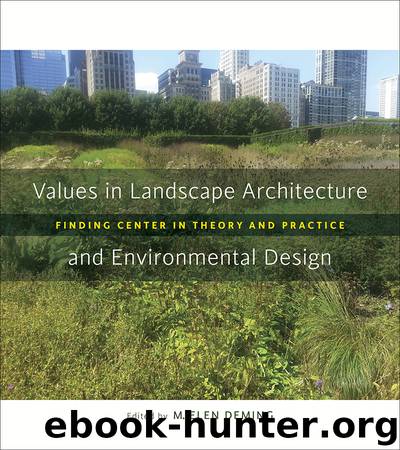Values in Landscape Architecture and Environmental Design by M. Elen Deming

Author:M. Elen Deming
Language: eng
Format: epub
Publisher: Louisiana State University Press
Published: 2015-03-18T04:00:00+00:00
Fig. 7.6. Detail of Trooper no. 17. Photo from Carol Highsmith Collection, Library of Congress.
Although the circulation pattern at the Korean War Veterans Memorial has been praised for its “clarity,” its very compactness allows the visitor’s commemorative experience (including an openness to value messages) to be marred by distractions that are not part of the design. Two of these distractions—which should, perhaps, have been predicted and mitigated in the design process—are photography and floral tributes.
The memorial is highly photogenic. Each one of the nineteen sculpted faces holds perfectly still for as long as it takes the pickiest photographer to get multiple perfect portraits. The postures and interactions of the troopers, the reflections on the mural wall and in the circular pool, the multiple viewpoints for each design element—all encourage photographers by providing appealing challenges to the amateur’s image-composing ability.13 On the National Mall, only the FDR Memorial competes with, and perhaps trumps, the KWVM in its multiplicity of opportunities for photographic creativity. This isn’t surprising, for both memorials are garden landscapes in which multiple naturalistic elements are employed to create complex narratives, and both are sandwiched, on the timeline of National Mall commemorations, between the minimalism of the VVM and the cold monumentality of the World War II and Martin Luther King memorials. Because of the diffusion of symbolic episodes in Halprin’s FDR Memorial, there is plenty of room for visitors to compose shots without the constant threat of other visitors moving through the frame. The opposite occurs in the KWVM’s confined space, where every step a visitor takes can ruin another visitor’s photo opportunity. The pedestrian traffic jams at the apex are reminiscent of a six-way vehicle intersection where no one knows who has the right of way. The comedic “after you, Alphonse,” routines among photographers can’t be the kind of value-centered visitor interaction the designers and sponsors were hoping for.
The sense of experience shared with people one doesn’t know is an essential element in the patriotic values the sponsors wanted the KWVM to impart or elicit. As Kirk Savage (2009, 275) has described in his discussion of the “participatory” quality of the VVM experience, one receives that sense walking along the Vietnam wall, notwithstanding the absence of intentional value statements. But, ironically, it can be missing in the experience of the KWVM. Picture-taking, like talking on a cell phone, excludes the strangers around you (from your concentrated activity, if not from your photo), and the surfeit of photography at the KWVM exacerbates the feeling of disconnectedness with fellow visitors.
Writing similarly about Thiepval, the Edwin Lutyens–designed memorial in northern France to British soldiers missing in World War I, Savage notes that, while most commentators focus on the visitor’s personal elegiac experience, that monument should also be seen as “a shared space, a collective experience shared both synchronically (with others at that very moment) and diachronically (with all those who have come before, deposited wreaths and flowers long since withered)” (2010, 649).
Many floral wreaths have been “deposited” at the Korean War Veterans Memorial over the years, and the flowers are seldom allowed to wither.
Download
This site does not store any files on its server. We only index and link to content provided by other sites. Please contact the content providers to delete copyright contents if any and email us, we'll remove relevant links or contents immediately.
Kathy Andrews Collection by Kathy Andrews(11326)
The remains of the day by Kazuo Ishiguro(8396)
Paper Towns by Green John(4800)
Spare by Prince Harry The Duke of Sussex(4789)
Industrial Automation from Scratch: A hands-on guide to using sensors, actuators, PLCs, HMIs, and SCADA to automate industrial processes by Olushola Akande(4609)
The Body: A Guide for Occupants by Bill Bryson(4586)
Be in a Treehouse by Pete Nelson(3648)
Machine Learning at Scale with H2O by Gregory Keys | David Whiting(3634)
Harry Potter and the Goblet Of Fire by J.K. Rowling(3611)
Never by Ken Follett(3529)
Goodbye Paradise(3448)
The Remains of the Day by Kazuo Ishiguro(3139)
Into Thin Air by Jon Krakauer(3131)
The Cellar by Natasha Preston(3077)
The Genius of Japanese Carpentry by Azby Brown(3040)
Fairy Tale by Stephen King(2950)
120 Days of Sodom by Marquis de Sade(2941)
Drawing Shortcuts: Developing Quick Drawing Skills Using Today's Technology by Leggitt Jim(2941)
The Man Who Died Twice by Richard Osman(2809)
